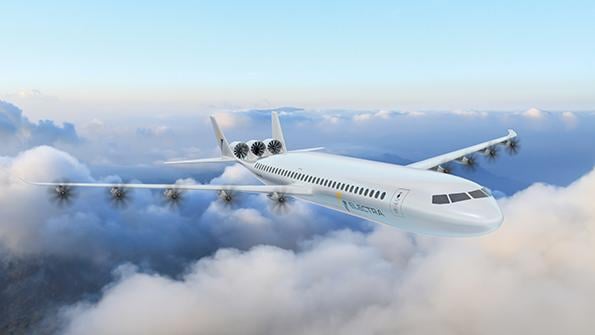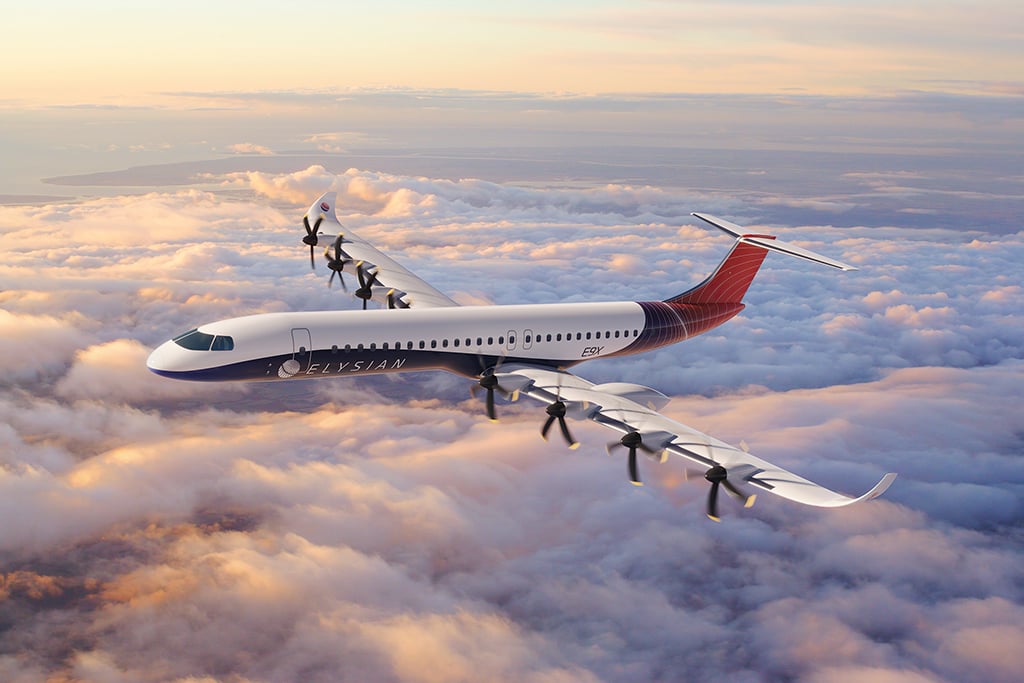This article is published in Aviation Week & Space Technology and is free to read until Aug 15, 2024. If you want to read more articles from this publication, please click the link to subscribe.

With distributed hybrid-electric propulsion, Electra’s 200-seater would consume half the fuel of today’s narrowbodies.
How radical is the aviation industry prepared to be to meet its stated goal of being carbon net-zero by 2050? That is the question increasingly being asked by researchers and startups prepared to challenge the industry’s assumptions.
One of those assumptions is that sustainable aviation fuel (SAF) alone will be the largest contributor to the decarbonization of aviation. Another is that electric and hydrogen propulsion will be limited to short flights in small aircraft and will not contribute meaningfully before 2050.
But airline leaders are already sounding the alarm on the availability of SAF in the volumes required by 2050, some warning that it is almost certain the industry will miss its target. At the same time, more voices are saying aviation needs to be more aggressive in embracing new-technology aircraft.
Growth projections for air traffic show the aviation industry will not be able to decarbonize by 2050 if it follows the trend of incremental improvements, German aviation think tank Bauhaus Luftfahrt, which counts Airbus among its backers, said.

“To achieve climate neutrality by 2050, aviation must overcome the current lack of sufficiently mature decarbonization technologies, the necessary infrastructure and sufficient investment. What matters now is speed and radicalism across the entire aviation system,” Bauhaus Luftfahrt executive director of research and technology Mirko Hornung said.
John Langford, founder and CEO of hybrid-electric startup Electra.aero, points to a chart from the 2021 US Aviation Climate Action Plan, which shows SAF being by far the biggest contributor to achieving the goal of net-zero carbon emissions by 2050. A thin blue wedge on the chart is labeled “new aircraft tech.”
“The US Aviation Climate Action Plan is basically just SAF. The new aircraft technology share is pathetic,” Langford said. “There is a lot more that needs to be done there, as SAF does not change the carbon coming out of the tailpipe.” Langford also pointed to the impact that advanced propulsion technologies will have toward achieving real reductions in emissions beyond 2050.
THREE ROUTES TO DECARBONIZATION
In a report released in late May, Bauhaus presented three scenarios outlining potential pathways to decarbonization. In the first scenario, an aggressive increase in SAF production of 17% per year to 2050, plus the introduction in 2030-35 of conventional aircraft that are at least 15% more efficient, brings aviation closer to net-zero by the middle of the century.
In Bauhaus’ radically efficient aircraft scenario, the vigorous ramp-up in SAF production is combined with the introduction in 2040-45 of revolutionary kerosene-fueled aircraft consuming 50% less fuel. This enables decarbonization to be achieved slightly more quickly and with lower cumulative emissions and fuel costs than the SAF-only scenario.

The think tank does not see hydrogen playing much of a role before 2050. In its third scenario, an aggressive introduction of hydrogen in 2040-50 is combined with a slower increase in SAF production of 9% per year. “In this scenario, aviation will not be decarbonized by 2070,” Bauhaus said.
Europe’s Alliance for Zero-Emission Aviation (AZEA) does see a greater role for electric and hydrogen propulsion. Launched by the European Commission and including aircraft manufacturers, airlines, airports, fuel providers, certification agencies, and passenger and environmental interest groups, AZEA released its vision document in June, presenting two scenarios.
Extrapolating from current planned aircraft deliveries and assuming no additional policy support, AZEA’s baseline scenario foresees around 20,000 aircraft delivered in Europe in 2023-50. Assuming accelerated uptake of new technologies and stronger growth in regional and short-haul traffic, the alliance’s ambitious scenario forecasts deliveries increasing to nearly 40,000 aircraft.
“With the introduction of electric and hydrogen aircraft, AZEA’s baseline scenario estimates that ... short- and medium-haul emissions will fall 12% by 2050. However, under AZEA’s ambitious scenario ... short- and medium-haul emissions could fall by up to 31%,” the alliance said, adding the potential for CO2 savings beyond 2050 is much greater given lengthy aircraft development and fleet renewal cycles.
EMBOLDENED STARTUPS
The growing discussion of the need for a more radical approach has emboldened startups. Dutch newcomer Elysian is one of those challenging the belief that battery-powered aircraft must be small and short-range, proposing to develop a 90-seat, 500 mi.-range (434 nm) all-electric airliner for service entry by 2035.
“If you want to make a significant impact on the sector as a whole, then you need to electrify flights up to 1,000 km [620 mi.; 539 nm]. Then you are talking about roughly one-fifth of aviation emissions and about half of all passenger flights,” Elysian director design and engineering Reynard de Vries said.
Inspired by the inefficient first generation of jet airliners, in which fuel accounted for almost half the weight, Elysian has proposed an Airbus A320-sized aircraft with batteries that make up a similar portion of the aircraft’s weight.
“These numbers start meaning that if you can also get the costs down, if you can get enough people on the plane, then perhaps from a cost perspective, it makes sense not to operate on new segments of mobility and in new markets but to compete with current aircraft,” de Vries said.
Echoing Elysian’s “bigger is better” thinking, Whisper Aero cofounder and CEO Mark Moore said, “Smaller aircraft are not more feasible for battery electric.” Created to develop quiet electric ducted fans, Whisper has unveiled a concept for a 100-seat, 770 mi.-range (669 nm) all-electric airliner for 2035.
“We wanted to see if battery-electric aircraft could outcompete economically hydrocarbon-based solutions, so that it becomes a rational business decision to go to a zero-emission aircraft and retire the existing fleet,” Moore said. Whisper has submitted the concept for a NASA program to study designs for an airliner that could enter service in the 2040s to help aviation meet its net-zero 2050 goals.
Electra.aero is targeting the same NASA program with a 200-seat airliner concept using distributed hybrid-electric propulsion to cut fuel consumption by 50% over 1,000 mi. stage lengths. The design is an extrapolation of technology in Electra’s first planned product, a nine-seat short-takeoff regional aircraft. “First-generation hybrid-electric with an existing turbine works, but it’s only scratching the surface,” Langford said.
“The initial economics of deploying electric and hydrogen aircraft must not become an obstacle to long-term success, and early adopters should be encouraged,” AZEA noted in its vision document. “The transition to electric and hydrogen aviation represents a considerable challenge ... [but] beyond those hurdles is an opportunity that is even greater—to reshape the way we travel.”





